
By Sarah Harper, NP
Reiki is a Japanese form of energy healing that can be utilized for health promotion and stress reduction. A licensed Reiki practitioner will allow a patient to connect with their own innate healing energy and restore the body and spirit to balance. When in a state of harmony, “rei” (meaning “universal/higher consciousness”) and “ki” (meaning “life energy”) should flow freely throughout the body and mind. When energy becomes stagnant and is unable to flow, the physical body may become weakened and more susceptible to disease. A Reiki session can help to dissolve energy blockages and facilitates healing spiritually, emotionally and mentally.
Reiki began as a healing organization in Japan in the 1800s and was created by Usui Mikao. This organization focused on the use of positive energy to heal the mind, body and soul. Reiki has now spread throughout the Eastern and Western hemispheres.
A Reiki session is typically 60-90 minutes. A discussion will take place before the initial session with a Reiki Practitioner to discuss medical and social history. During a Reiki session, the patient will rest comfortably on a table or in a chair with their shoes removed. Patients remain fully clothed during the session. A practitioner can either perform Reiki with light touch or with their hands held slightly above the body based on patient preference. A recipient of Reiki may experience warmth, tingling, or deep relaxation during the session. Reiki is not used to treat or cure disease, but rather to further assist the body to heal itself when used in conjunction with other healing modalities.